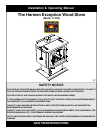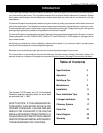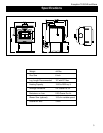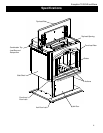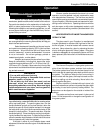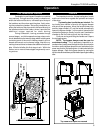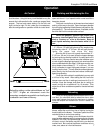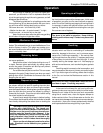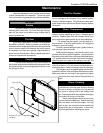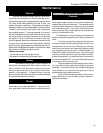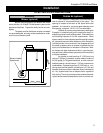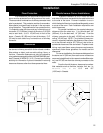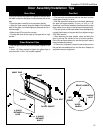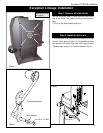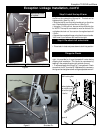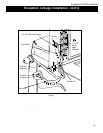
Exception TL200 Wood Stove
5
All doors must be closed while the stove is in normal
operation, and the gaskets routinely examined for wear
and replaced when necessary. The fuel door may be left
open and the opening covered with a screen when operat-
ing as a fireplace. Good door seals are important for main-
taining control of the stove. Operating the stove with the
ash door open, or with a door inadequately sealed, could
create a serious overfiring condition (discussed later in this
section).
NEVER OPERATE WITH MORE THAN ONE DOOR
OPEN AT A TIME
The glass used in your Exception is manufactured
to exact standards to withstand the high heat of the fire,
but like all glass, it must be treated with common sense
and care. Never abuse the glass by slamming the door
shut or striking the glass with a heavy object. If the glass
is broken or damaged, do not operate the stove until it has
been replaced (See instructions in the Maintenance sec-
tion.)
Grates
The Harman Exception’s unique grate system con-
sists of two flat bottom grates, and two front andirons.
The bottom grates have slots which allow the ash to fall
into the ash pan by passing a poker back and forth across
the grates. The andirons keep the fuel from coming in
direct contact with the glass, and keep hot coals and em-
bers from spilling out while reloading. Never build a fire
directly against the glass.
Andiron extensions (included with each stove) clip
onto the fixed andirons and serve to protect the glass when
top loading is used as the primary loading method. The
extensions can be clipped on the outside or inside of the
andirons.
The grates and andirons must remain in place at all
times. Do not tamper with or change the configuration of
this grate system.
Operation
General Considerations
Draft
Before you install and operate your Exception
wood stove, please read the entire contents of this manual.
Pay particular attention to the explanation of draft and its
effect on stove performance in the venting section. By
following the installation and operating guidelines, you will
ensure proper draft and gain
maximum efficiency and en-
joyment from your stove.
Fuel
Your Exception burns wood very efficiently. Here
are some guidelines concerning firewood that will help you
obtain the best performance.
Select hardwoods if possible, as they are heavier
and contain more heating capacity (BTU’s) per load than
do softwoods. Wood should be split and stored under
cover for “seasoning” - a year is recommended. Your stove
is not an incinerator - do not burn garbage, painted or
treated wood, plastic, or other debris.
Keep the area around the stove free from clutter.
Keep all combustibles, including fuel, beyond the code-
required clearance distance (48" or 1215 mm in the U.S.,
1525 mm or 60" in Canada). Never store fuel in front of the
stove where it could interfere with door operation, safe load-
ing, and ash removal.
WARNINGS
• For use with solid wood fuel only.
• Do not burn garbage or flammable fluids such as
gasoline, naptha, or engine oil.
• Do not burn any fuel other than wood, such as
charcoal, which can cause increased carbon
monoxide production or overfiring. Never use highly
volatile substances in your stove, such as gasoline,
which could cause an explosion.
The Stove
Doors
Your stove has a large glass-paneled door for load-
ing and fireviewing, a separate smaller door for removing ashes
and a top loading door. To open the glass door, turn the
handle clockwise and pull out; to close the door, return the
handle to an open (9 o'clock) position and push in to engage
the latch while turning the handle counterclockwise to the
closed (6 o'clock) position. To open the ash door, lift up the
handle and pull out. Close the door by pushing in and push-
ing the handle all the way down. To open the top load door
move the wooden knob located on the left side of the stove
front and upward until it locks the top open.
If the latch in either of your Exception doors needs
adjustment, follow the instructions given in the Maintenance
section.



